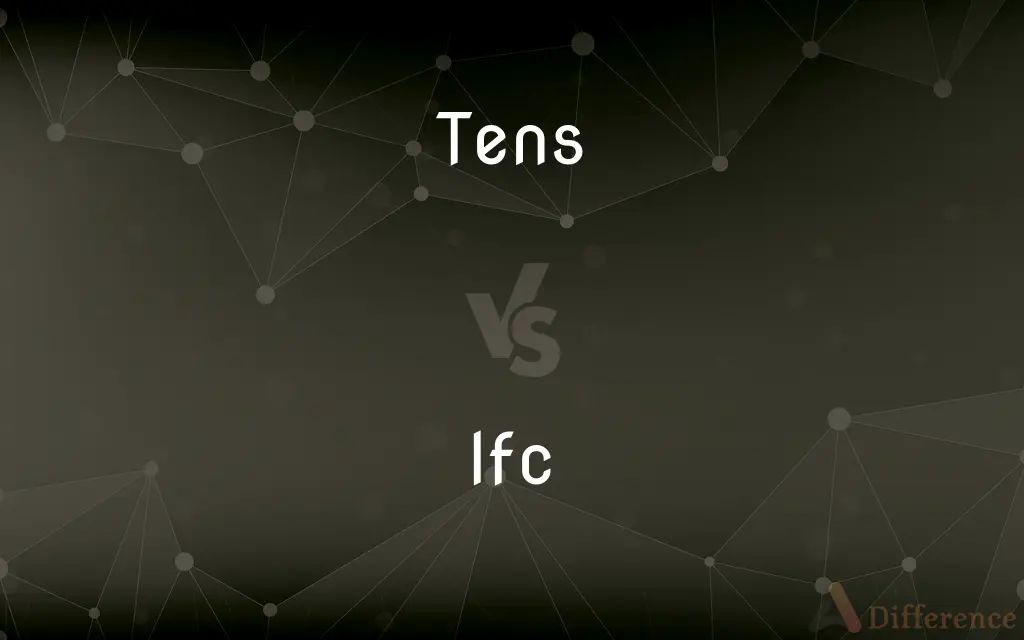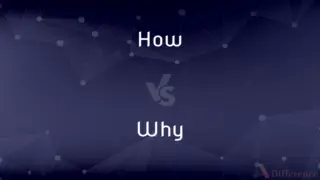TENS vs. IFC — What's the Difference?
By Fiza Rafique & Maham Liaqat — Updated on March 20, 2024
TENS (Transcutaneous Electrical Nerve Stimulation) uses low-voltage electrical currents for pain relief, while IFC (Interferential Current) employs medium frequency currents for deeper tissue penetration.

Difference Between TENS and IFC
Table of Contents
ADVERTISEMENT
Key Differences
TENS, or Transcutaneous Electrical Nerve Stimulation, involves the application of low-voltage electrical currents through the skin to relieve pain, primarily targeting surface nerves. It is commonly used for chronic pain conditions and post-operative pain. TENS units are portable and can be used by patients at home. Whereas, IFC, or Interferential Current therapy, uses medium frequency electrical currents that intersect below the skin to treat deep muscle pain. This method is believed to be more effective in reaching deeper tissues without discomfort at the skin level, making it suitable for treating conditions like deep muscle spasms, inflammation, and pain.
TENS therapy is designed for pain management and operates at a lower frequency, which affects the sensory nerves to block pain signals to the brain. This modality is often used for acute and chronic pain relief. On the other hand, IFC therapy works by delivering higher frequency currents that penetrate deeper into the muscle tissues, providing relief for more profound pain and facilitating muscle healing and blood flow.
The application of TENS involves placing electrodes near the pain site or along a related nerve pathway. This approach is flexible and allows users to adjust settings for intensity and frequency according to their comfort and pain level. IFC, however, often requires professional administration and the electrode placement aims to target deep tissue layers, utilizing a crisscross pattern to maximize the therapy's effectiveness.
While TENS units are widely accessible for personal use, enabling individuals to manage their pain treatment at home or on the go, IFC therapy typically occurs in a clinical setting. This difference underscores TENS's adaptability for regular, personal pain management, whereas IFC's application is more controlled and focused on specific, deeper-seated issues.
In terms of user experience, TENS therapy may be felt as a tingling sensation on the skin, which can be adjusted to ensure comfort while still blocking pain signals. IFC therapy, while aiming for deeper tissue, is also designed to be comfortable, with patients often feeling a deeper, therapeutic sensation that targets the source of their pain more effectively.
ADVERTISEMENT
Comparison Chart
Frequency
Low-voltage electrical currents
Medium frequency currents
Pain Target
Surface nerves for pain relief
Deep muscle tissues
Usage Setting
Home or clinical, with portable devices
Primarily clinical
Application Method
Electrodes placed on or near the pain area
Electrodes placed in a crisscross pattern for deep penetration
Ideal For
Chronic pain, post-operative pain, and acute pain relief
Deep muscle spasms, inflammation, and pain
Compare with Definitions
Tens
It operates through low-voltage electrical currents.
The TENS device emits electrical impulses that intercept pain signals to the brain.
Ifc
Mostly administered in clinical settings.
Her physiotherapist recommended weekly IFC sessions for her chronic neck pain.
Tens
TENS is used for managing different types of pain.
A person with chronic back pain uses a TENS unit daily for relief.
Ifc
Utilizes medium frequency electrical currents.
IFC's medium frequency currents penetrate deeper than traditional electrical stimulation.
Tens
TENS provides a non-invasive method for pain relief.
After knee surgery, the patient opted for TENS to avoid taking too many painkillers.
Ifc
IFC therapy is effective for deep muscle tissue pain.
The athlete underwent IFC therapy to recover from a deep muscle injury.
Tens
TENS devices are portable and user-friendly.
She carries her TENS unit in her purse for quick access whenever her sciatica acts up.
Ifc
It operates by passing two medium frequency currents.
IFC therapy's unique current intersection helps reach deeper affected areas effectively.
Tens
Users can adjust the intensity of the electrical stimulation.
He found the perfect TENS setting that provides maximum relief without discomfort.
Ifc
A United Nations agency that invest directly in companies and guarantees loans to private investors; affiliated with the World Bank
Tens
A technique used to relieve pain in an injured or diseased part of the body in which electrodes applied to the skin deliver intermittent stimulation to surface nerves, blocking the transmission of pain signals.
Tens
Plural of ten
Tens
An inexact quantity, typically understood to be between 20 and 100.
Our houses are tens of meters apart, so we don't have to worry about noise from our neighbours.
Tens of thousands of voters
Tens
(poker slang) A pair of tens.
Tens
The second decade of a century: the 1910s, 2010s, etc. The teens, the oneties.
Common Curiosities
Is IFC therapy painful?
IFC therapy is generally not painful; it aims to deliver a deeper therapeutic sensation to target areas without discomfort.
Which therapy is more effective for deep tissue pain?
IFC is considered more effective for deep tissue pain due to its medium frequency currents that reach deeper layers.
Are there any side effects to using TENS?
TENS is safe for most people, but skin irritation can occur under the electrodes with prolonged use.
What conditions can benefit from IFC therapy?
Conditions such as deep muscle spasms, severe arthritis, and certain types of chronic pain can benefit from IFC therapy.
Do I need a prescription to use a TENS unit?
In many places, a prescription is not required for a TENS unit, though it may be recommended to consult with a healthcare provider first.
What is TENS therapy best used for?
TENS is best for managing chronic pain, acute pain, and post-operative pain through electrical nerve stimulation.
How does IFC therapy work?
IFC uses two intersecting medium frequency currents to penetrate deep muscle tissues, enhancing pain relief and healing.
Can TENS therapy be used at home?
Yes, TENS devices are portable and designed for easy use at home or on the go.
How long does a typical TENS session last?
A typical TENS session can last from 15 minutes to an hour, depending on the pain level and treatment goals.
Can TENS therapy be used for all types of pain?
While TENS is versatile, it is most effective for nerve-related pain and may not be suitable for all types.
Is TENS or IFC better for post-operative pain?
TENS is commonly used for post-operative pain due to its effectiveness in blocking pain signals at the skin level.
What makes IFC therapy unique compared to other electrical stimulation therapies?
IFC's uniqueness lies in its use of intersecting currents to reach deeper tissues effectively, providing targeted pain relief and muscle healing.
How often can IFC therapy be administered?
The frequency of IFC therapy sessions varies based on the condition being treated and is typically determined by a healthcare professional.
Can TENS and IFC therapies be combined?
In some treatment plans, both TENS and IFC therapies can be combined for comprehensive pain management, under professional guidance.
Share Your Discovery

Previous Comparison
Deluxe vs. Superior
Next Comparison
How vs. WhyAuthor Spotlight
Written by
Fiza RafiqueFiza Rafique is a skilled content writer at AskDifference.com, where she meticulously refines and enhances written pieces. Drawing from her vast editorial expertise, Fiza ensures clarity, accuracy, and precision in every article. Passionate about language, she continually seeks to elevate the quality of content for readers worldwide.
Co-written by
Maham Liaqat














































